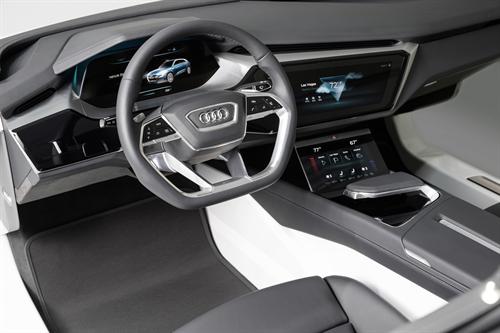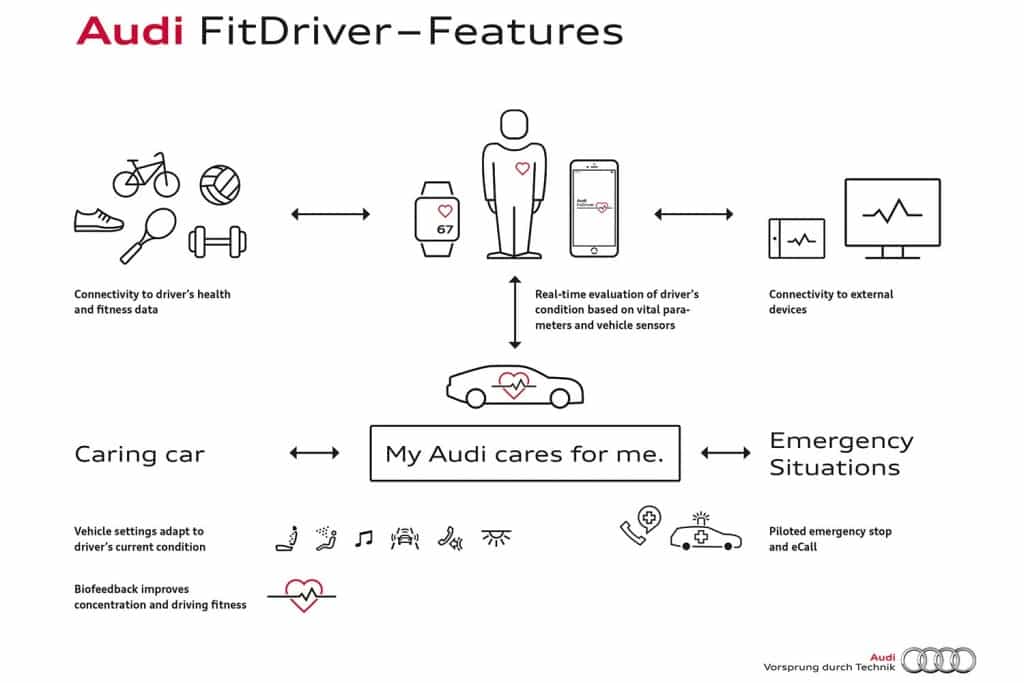 Audi showed its plans for infotainment, connectivity and self-driving at CES. Drivers will be able to connect their smartphones and watch Apple TV, the infotainment system learns the driver’s preferences, there will be 4G LTE connections, vehicle-to-traffic information and breathing instructions when the driver is stressed.
Audi showed its plans for infotainment, connectivity and self-driving at CES. Drivers will be able to connect their smartphones and watch Apple TV, the infotainment system learns the driver’s preferences, there will be 4G LTE connections, vehicle-to-traffic information and breathing instructions when the driver is stressed.
Vehicle-to-Infrastructure
This year Audi is expanding its connect portfolio to include the first Car-to-X services. The new services “traffic sign information” and “hazard information” make the brand’s new models part of a swarm. The service “traffic light information online” (for the USA) connects the car via the mobile phone network to the central traffic computer that controls the traffic lights in the city.
New Infotainment HMI with Apple TV
Audi showed its commitment to easy-to-use HMI, human-machine interface with the Audi virtual cockpit with the Audi virtual dashboard. The system learns the drivers habits and preferences, then supports them.
The large AMOLED (active-matrix organic light-emitting diode) displays integrate haptic feedback. The new type of MMI control with “MMI touch response” recognizes familiar touch gestures from the consumer electronics world and adapts them to the special operating environment in the automobile.
Smartphones and smartwatches can be seamlessly connected. Behind the new operating and display concept is the next generation of Audi’s Modular Infotainment Platform, MIB2+ with wireless communication through LTE Advanced.
Drivers can display the location of their car on their smartphone, for example. It will also be available for fourth-generation Apple TV from 2016. Starting in 2016, the Audi connect SIM will bring Audi connect services in Europe on board with no activation procedure and enable automatic EU-wide roaming.
Audi Self-Driving
The Audi e-tron quattro concept showed all piloted driving functions, including piloted driving in traffic jams and piloted parking. These services represent safety, time-savings, efficiency and convenience, particularly in situations in which the driver is either overwhelmed or under-challenged.
The core component of future systems will be the central driver assistance controller, known as the zFAS. The information supplied by all sensors – including the signals from the 3D cameras, the laser scanner and the radar and ultrasonic sensors – is permanently fed into and processed by this compact module. Thanks to its enormous computing power the zFAS will be capable of continuously comparing the data from the vehicle sensor systems with the model of the road space and its surroundings.
Audi Fit Driver
The Audi Fit Driver project focuses on the well-being and health of the driver. A wearable (fitness wristband or smartwatch) monitors important vital parameters such as heart rate and skin temperature. Vehicle sensors supplement this data with information on driving style, breathing rate and relevant environmental data such as weather or traffic conditions. The current state of the driver, such as elevated stress or fatigue, is deduced from the collected data. As a result, various vehicle systems act to relax, vitalize, or even protect the driver.
Upon detecting increased stress, Audi Fit Driver shows a video tutorial in the cockpit for a specially designed breathing exercise for biofeedback.
Intelligent rest break management considers current traffic flow when recommending a break, allowing the driver to relax at the nearest rest area instead of being stuck in traffic.
In a later project phase, Audi Fit Driver will incorporate driver assistance and safety systems, as well as future piloted driving functions. In extreme situations, the car can execute a piloted emergency stop and place an emergency call via the eCall system.

HERE & Audi
Audi will be able to draw on the highly up-to-date cloud data in the HERE database. AUDI AG, the BMW Group and Daimler AG acquired HERE in December 2015. In future, self-driving vehicles will need a new data basis for the navigation map that is precise to the centimeter. By drawing on the live data from HERE, the vehicle will know what to expect along its route. That is the basis it needs to evaluate any changes and movements, as well as identify potential hazards, as rapidly as possible.
Electric Concept SUV with 310 Miles per Charge
The Audi e-tron quattro concept study, a fully-electric sport SUV, is on display at the CES to illustrated Audi’s electrification strategy. The 95 kWh battery allows for a range of up to 500 kilometers (310.7 mi). A future production model is expected to be launched in 2018.
Audi Uses Qualcomm Chips
Audi also announced an agreement with Qualcomm. Qualcomm Snapdragon 602A processors were selected for Audi’s 2017 vehicles. Announced at CES in January 2014, the Snapdragon 602A is Qualcomm Technologies’ first automotive grade infotainment chipset and is designed to meet stringent automotive industry standards while delivering advanced smartphone-quality connectivity, infotainment, navigation, voice quality and control features in cars.